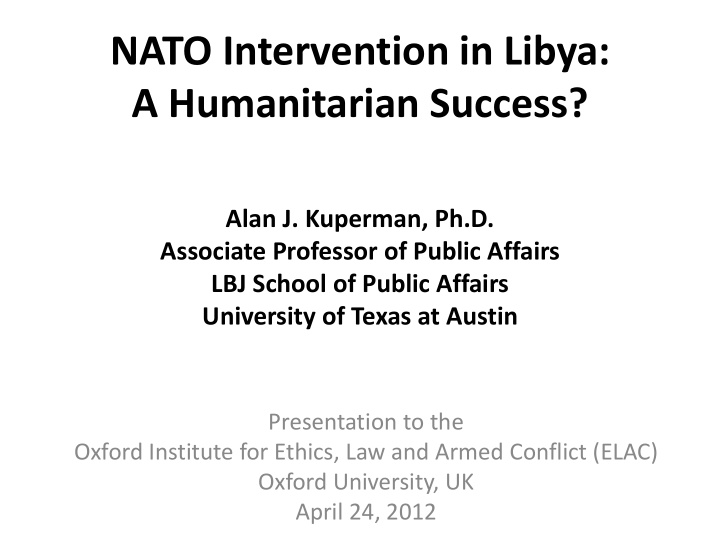



NATO Intervention in Libya: A Humanitarian Success? Alan J. Kuperman, Ph.D. Associate Professor of Public Affairs LBJ School of Public Affairs University of Texas at Austin Presentation to the Oxford Institute for Ethics, Law and Armed Conflict (ELAC) Oxford University, UK April 24, 2012
Common Narrative: Libya is R2P Success! • Initially peaceful, nationwide uprising vs. dictator • Qaddafi kills 1000s of peaceful protesters in 3 days • Killing spurs armed rebellion in self-defense • Security forces launch indiscriminate artillery, aerial attacks on civilians • Qaddafi threatens “bloodbath” in Benghazi • UN/NATO intervene to “protect civilians” • Nationwide support of rebels enables their victory • Conclusion: NATO intervention prevented a bloodbath and promoted freedom, democracy
Did Qaddafi Target Peaceful Civilians? • Benghazi protesters were armed and violent from first day. Used firearms, petrol bombs, vehicles to capture army garrison in 3 days • Security forces refrained from gunfire until protesters turned violent. Then, initially shot to wound, not kill • Initial death toll < 10% of reported level • Security forces very discriminate in Misurata – 3% of wounded are women (HRW, April 2011) – 257 killed out of 400,000 in 1 st two months of war • No bloodbaths in recaptured cities • In Benghazi, threatened only remaining rebels
NATO Intervention to Protect Civilians? • Targeted retreating security forces • Targeted security forces in areas where civilians supported Qaddafi and thus were not at risk • Provided intelligence to rebels, and facilitated their arming & training • Continued bombing despite rebels repeatedly rejecting cease-fire offers, prolonging war and civilian suffering
Outcome w/o NATO Intervention? • 5-week war • 1,000 deaths (estimated): – Benghazi & east: 400 – Misurata: 200 – Tripoli 200 – Zawiyah 170 – Central Libya 10s
Outcome w/ NATO Intervention • 36-week war (8 months) • 8,000 - 30,000 deaths 8,000 (U.S. estimate, Nov 2011) 30,000 (Libya estimate, Sept 2011) 15,000 security forces 15,000 others – 2,000 rebels & civilians in Misurata – 1,700 rebels, 100 civilians in Tripoli’s fall
Post-War Libya • Rebel reprisals kill 100s • Ethnic cleansing of “black” town of Tawergha • Rival militias – including radical Islamists – fight for control of cities, neighborhoods • Oil-rich, eastern Libya threatens secession • HRW says former rebels continue “crimes against humanity” in Misurata (April 2012) • 42% of Libyans want strongman like Qaddafi
Regional Spillover • Mali : Weapons from Libya Tuareg rebellion IDPs, secession, and coup • Syria : NATO intervention for Libyan rebels Syria’s peaceful protests turn violent Assad escalates crackdown Death toll accelerates • Somalia : Weapons from Libya rebels bolstered Civil war exacerbated? • Proliferation: Surface-to-air missiles (MANPADs) still missing
Net Humanitarian Impact? • War perpetuated: 7X • Death toll magnified: 8X – 30X • Human rights situation unimproved, at best • Economy and governance damaged • Mali – civil war contagion and displacement • Syria – rebellion encouraged, toll escalates • Future benefits to compensate these costs???
Lessons 1 • Beware misinformation & disinformation: – Regional rebellion ≠ democratic uprising – Urban counter- insurgency ≠ targeting civilians • Moral Hazard: “Humanitarian” intervention that benefits rebels may backfire by encouraging escalation in that conflict and others, raising the civilian toll. Can’t be justified on humanitarian grounds, unless state retaliation was grossly disproportionate.
Lessons 2 • Humanitarian intervention often devolves into regime change, because interveners won’t cut a deal with the regime that they have demonized. But this magnifies the human cost, undermining the original rationale. • Q: Can one support humanitarian intervention if one opposes the forcible overthrow of regimes that are not deliberately targeting civilians?
Recommend
More recommend